-
 Bitcoin
Bitcoin $106,754.6083
1.33% -
 Ethereum
Ethereum $2,625.8249
3.80% -
 Tether USDt
Tether USDt $1.0001
-0.03% -
 XRP
XRP $2.1891
1.67% -
 BNB
BNB $654.5220
0.66% -
 Solana
Solana $156.9428
7.28% -
 USDC
USDC $0.9998
0.00% -
 Dogecoin
Dogecoin $0.1780
1.14% -
 TRON
TRON $0.2706
-0.16% -
 Cardano
Cardano $0.6470
2.77% -
 Hyperliquid
Hyperliquid $44.6467
10.24% -
 Sui
Sui $3.1128
3.86% -
 Bitcoin Cash
Bitcoin Cash $455.7646
3.00% -
 Chainlink
Chainlink $13.6858
4.08% -
 UNUS SED LEO
UNUS SED LEO $9.2682
0.21% -
 Avalanche
Avalanche $19.7433
3.79% -
 Stellar
Stellar $0.2616
1.64% -
 Toncoin
Toncoin $3.0222
2.19% -
 Shiba Inu
Shiba Inu $0.0...01220
1.49% -
 Hedera
Hedera $0.1580
2.75% -
 Litecoin
Litecoin $87.4964
2.29% -
 Polkadot
Polkadot $3.8958
3.05% -
 Ethena USDe
Ethena USDe $1.0000
-0.04% -
 Monero
Monero $317.2263
0.26% -
 Bitget Token
Bitget Token $4.5985
1.68% -
 Dai
Dai $0.9999
0.00% -
 Pepe
Pepe $0.0...01140
2.44% -
 Uniswap
Uniswap $7.6065
5.29% -
 Pi
Pi $0.6042
-2.00% -
 Aave
Aave $289.6343
6.02%
Must the dark cloud cover candlestick combination be sold? How high is the historical accuracy?
The Dark Cloud Cover is a bearish reversal candlestick pattern signaling potential trend shifts, but it should be confirmed with other indicators before making trading decisions.
Jun 14, 2025 at 11:00 am
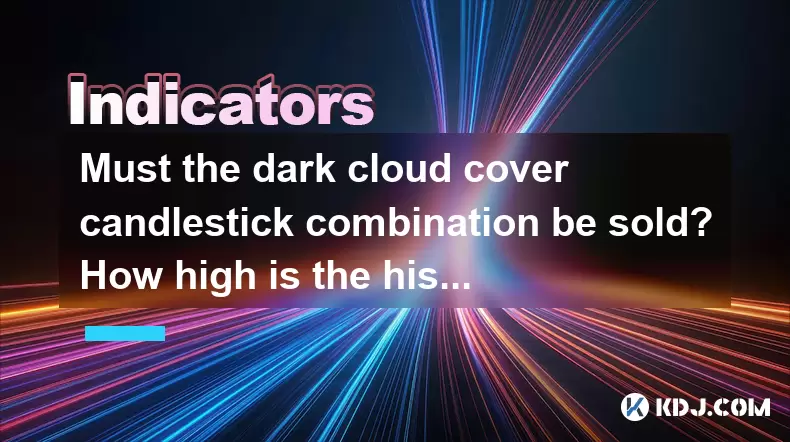
Understanding the Dark Cloud Cover Candlestick Pattern
The Dark Cloud Cover is a well-known candlestick pattern in technical analysis, particularly among traders active in the cryptocurrency market. It is classified as a bearish reversal pattern, typically appearing at the end of an uptrend. This pattern consists of two candles: the first is a strong bullish (green) candle, followed by a bearish (red) candle that opens higher but closes below the midpoint of the previous candle.
Many traders interpret this formation as a sign that selling pressure has overtaken buying momentum, suggesting a potential reversal of the current uptrend. However, whether one must sell immediately upon seeing this pattern remains a debated topic within trading communities.
Important:
The Dark Cloud Cover should not be used in isolation for making sell decisions without confirming signals from other technical indicators or chart patterns.How to Identify the Dark Cloud Cover Pattern
Recognizing the Dark Cloud Cover requires careful observation of specific characteristics in candlestick formations. Here’s how to identify it step-by-step:
- Look for a clear uptrend in price movement.
- Spot a bullish candle with a large real body, indicating strong buying pressure.
- The next candle should open above the high of the previous candle — this is called a gap up.
- This second candle then proceeds to fall sharply and closes below the midpoint of the prior candle’s body.
- Ideally, the closing price should be near the low of the second candle's range.
This configuration visually represents a sudden shift in sentiment from bullish to bearish. Traders often use volume as a confirmation tool — if the second candle sees a surge in volume, it may reinforce the likelihood of a trend reversal.
Historical Accuracy of the Dark Cloud Cover Pattern
While the Dark Cloud Cover is widely taught and recognized, its historical accuracy can vary depending on the asset class and timeframe. In cryptocurrency markets, where volatility is high and trends can reverse quickly, the reliability of this pattern has been tested across multiple assets like Bitcoin, Ethereum, and altcoins.
Studies and backtesting conducted by analysts suggest that the accuracy rate ranges between 60% to 70%, assuming proper context and confirmation tools are applied. However, false signals are common, especially during sideways or consolidating markets.
It’s crucial to understand that no candlestick pattern guarantees success. The Dark Cloud Cover works best when combined with other forms of analysis such as moving averages, RSI divergence, or Fibonacci retracement levels.
Why Selling Isn’t Mandatory After a Dark Cloud Cover Signal
Despite being labeled as a bearish reversal signal, many experienced traders do not automatically sell upon encountering a Dark Cloud Cover. Here’s why:
- Market Context Matters: If the pattern appears in overbought territory or after a long rally, it might carry more weight. Conversely, in early-stage uptrends, it could be a temporary pullback rather than a full reversal.
- Volume Confirmation Is Essential: A lack of significant volume on the bearish candle may indicate weak selling pressure, reducing the strength of the signal.
- False Signals Are Common: Especially in highly volatile crypto markets, short-term wicks and reversals can create misleading candlestick patterns.
- Risk-Reward Ratio Should Be Evaluated: Instead of selling outright, some traders adjust stop-loss orders or take partial profits while waiting for further confirmation.
In short, reacting impulsively to a Dark Cloud Cover can lead to premature exits and missed opportunities if the market continues upward afterward.
How to Trade the Dark Cloud Cover Effectively
To make informed trading decisions using the Dark Cloud Cover, follow these steps:
- Confirm the presence of a clear uptrend before the pattern occurs.
- Use volume analysis to verify whether the bearish candle is supported by increased selling activity.
- Apply support and resistance levels to determine if the pattern aligns with key turning points on the chart.
- Consider using oscillators like RSI or MACD to detect divergences that support a reversal.
- Place a stop-loss order slightly above the high of the bearish candle to manage risk.
- Set realistic profit targets based on recent swing lows or measured moves.
By combining these techniques, traders can filter out weaker signals and improve their chances of capturing meaningful moves.
Frequently Asked Questions
Q: Can the Dark Cloud Cover appear in intraday charts?
Yes, it can appear on all timeframes including 1-hour, 4-hour, and daily charts. However, the significance increases on higher timeframes like the daily or weekly due to stronger confirmation.
Q: Is the Dark Cloud Cover applicable to all cryptocurrencies?
Yes, the pattern is applicable across various digital assets. However, its effectiveness may vary depending on the liquidity and volatility of each specific cryptocurrency.
Q: What should I do if the Dark Cloud Cover doesn’t result in a reversal?
If the price continues to rise despite the pattern, consider it a failed signal. Reassess your strategy, possibly tightening stops or re-entering on better confirmation if the trend resumes.
Q: How does the Dark Cloud Cover differ from the Bearish Engulfing pattern?
The Dark Cloud Cover only partially engulfs the prior candle’s body and typically shows a rejection at resistance, whereas the Bearish Engulfing completely swallows the previous candle, signaling stronger selling pressure.
Disclaimer:info@kdj.com
The information provided is not trading advice. kdj.com does not assume any responsibility for any investments made based on the information provided in this article. Cryptocurrencies are highly volatile and it is highly recommended that you invest with caution after thorough research!
If you believe that the content used on this website infringes your copyright, please contact us immediately (info@kdj.com) and we will delete it promptly.
- Arizona Senate, Bitcoin Reserve, Bill Revived: What's the Deal?
- 2025-06-20 12:25:12
- LayerZero's ZRO Price Under Pressure: Token Unlock Looms Large
- 2025-06-20 12:25:12
- Ripple, XRP, and Coinbase: Navigating Whale Movements and ETF Hopes
- 2025-06-20 12:45:13
- Bitcoin, Geopolitical Tensions, and Cheap Plays: A New Yorker's Take
- 2025-06-20 12:45:13
- Quantum Computing, Bitcoin, and Cryptographic Threats: A New York Minute on the Looming Crisis
- 2025-06-20 12:31:56
- Bitcoin ETFs, Institutional Inflows, and Market Trends: A New Yorker's Take
- 2025-06-20 12:51:45
Related knowledge
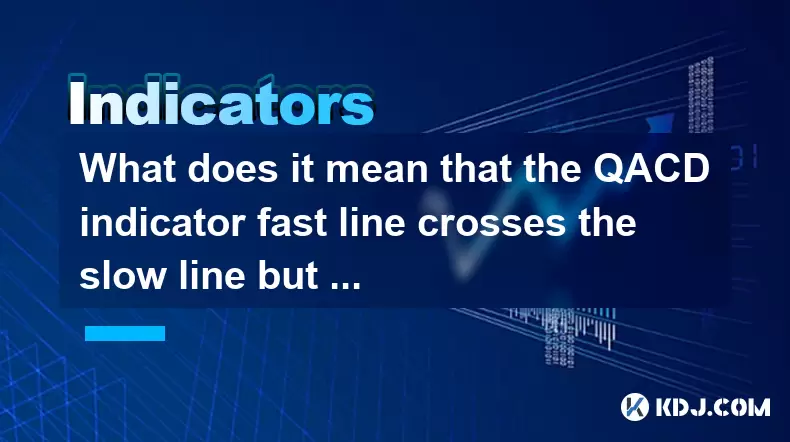
What does it mean that the QACD indicator fast line crosses the slow line but does not increase in volume?
Jun 20,2025 at 12:22pm
Understanding the QACD Indicator and Its ComponentsThe QACD (Quantitative Accumulation Convergence Divergence) indicator is a technical analysis tool used by traders to identify potential trend reversals, momentum shifts, and entry or exit points in cryptocurrency markets. It consists of two primary lines: the fast line, which reacts more quickly to pri...
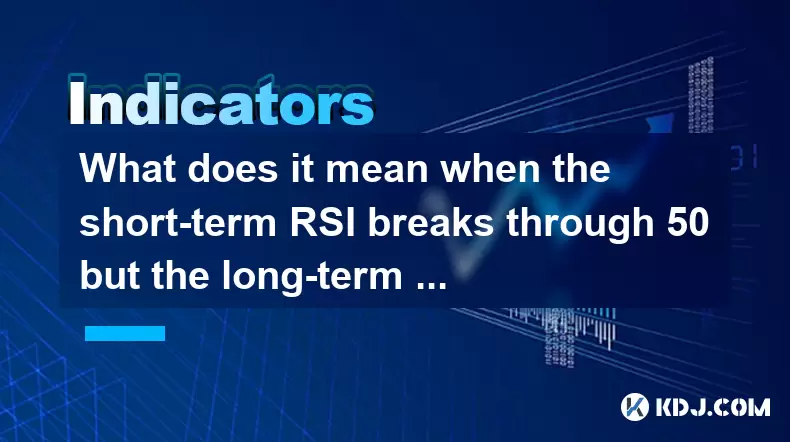
What does it mean when the short-term RSI breaks through 50 but the long-term RSI does not move in the RSI indicator?
Jun 20,2025 at 10:42am
Understanding the RSI Indicator and Its Dual-Term ApplicationThe Relative Strength Index (RSI) is a widely used momentum oscillator in technical analysis, primarily for identifying overbought or oversold conditions in an asset’s price movement. It typically operates on a scale from 0 to 100, with levels above 70 considered overbought and below 30 consid...
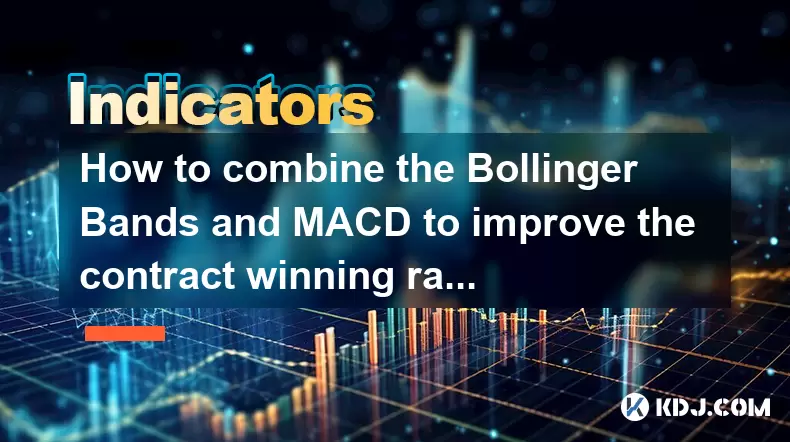
How to combine the Bollinger Bands and MACD to improve the contract winning rate?
Jun 19,2025 at 06:35pm
Understanding Bollinger Bands and MACD IndicatorsTo effectively combine Bollinger Bands and the MACD (Moving Average Convergence Divergence), it's essential to first understand what each indicator represents. Bollinger Bands consist of a middle moving average line and two outer bands that adjust based on market volatility. When prices move toward the up...
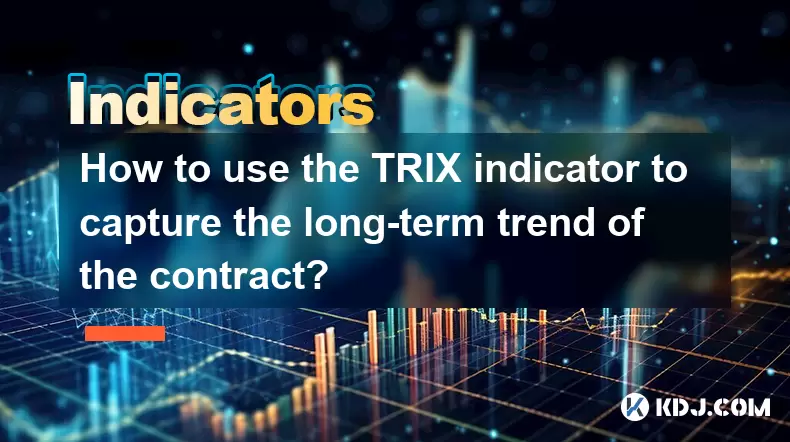
How to use the TRIX indicator to capture the long-term trend of the contract?
Jun 20,2025 at 09:14am
What Is the TRIX Indicator?The TRIX (Triple Exponential Average) indicator is a momentum oscillator used to identify oversold and overbought conditions, as well as potential trend reversals in financial markets. It is calculated by applying a triple exponential moving average to price data and then taking the percentage rate of change of that smoothed v...

How does the long lower shadow of the K line indicate the formation of the bottom of the contract?
Jun 19,2025 at 05:00am
Understanding the Long Lower Shadow in K-Line AnalysisIn cryptocurrency trading, K-line analysis plays a pivotal role in determining market sentiment and potential price reversals. A long lower shadow, also known as a long wick, is one of the most telling candlestick patterns that traders look for when assessing whether a bottom might be forming in a co...
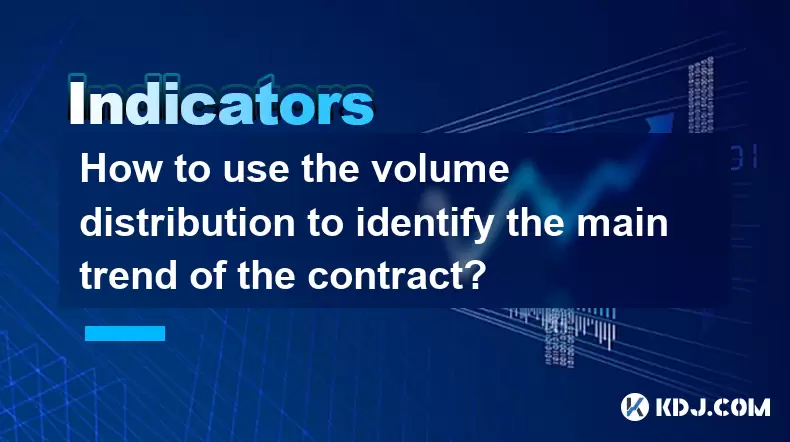
How to use the volume distribution to identify the main trend of the contract?
Jun 20,2025 at 03:56am
Understanding Volume Distribution in Cryptocurrency ContractsIn the realm of cryptocurrency trading, particularly within futures and perpetual contracts, volume distribution plays a pivotal role in deciphering market sentiment. Unlike spot markets, contract trading involves leveraged positions that can amplify both gains and losses. To navigate this com...

What does it mean that the QACD indicator fast line crosses the slow line but does not increase in volume?
Jun 20,2025 at 12:22pm
Understanding the QACD Indicator and Its ComponentsThe QACD (Quantitative Accumulation Convergence Divergence) indicator is a technical analysis tool used by traders to identify potential trend reversals, momentum shifts, and entry or exit points in cryptocurrency markets. It consists of two primary lines: the fast line, which reacts more quickly to pri...

What does it mean when the short-term RSI breaks through 50 but the long-term RSI does not move in the RSI indicator?
Jun 20,2025 at 10:42am
Understanding the RSI Indicator and Its Dual-Term ApplicationThe Relative Strength Index (RSI) is a widely used momentum oscillator in technical analysis, primarily for identifying overbought or oversold conditions in an asset’s price movement. It typically operates on a scale from 0 to 100, with levels above 70 considered overbought and below 30 consid...

How to combine the Bollinger Bands and MACD to improve the contract winning rate?
Jun 19,2025 at 06:35pm
Understanding Bollinger Bands and MACD IndicatorsTo effectively combine Bollinger Bands and the MACD (Moving Average Convergence Divergence), it's essential to first understand what each indicator represents. Bollinger Bands consist of a middle moving average line and two outer bands that adjust based on market volatility. When prices move toward the up...

How to use the TRIX indicator to capture the long-term trend of the contract?
Jun 20,2025 at 09:14am
What Is the TRIX Indicator?The TRIX (Triple Exponential Average) indicator is a momentum oscillator used to identify oversold and overbought conditions, as well as potential trend reversals in financial markets. It is calculated by applying a triple exponential moving average to price data and then taking the percentage rate of change of that smoothed v...

How does the long lower shadow of the K line indicate the formation of the bottom of the contract?
Jun 19,2025 at 05:00am
Understanding the Long Lower Shadow in K-Line AnalysisIn cryptocurrency trading, K-line analysis plays a pivotal role in determining market sentiment and potential price reversals. A long lower shadow, also known as a long wick, is one of the most telling candlestick patterns that traders look for when assessing whether a bottom might be forming in a co...

How to use the volume distribution to identify the main trend of the contract?
Jun 20,2025 at 03:56am
Understanding Volume Distribution in Cryptocurrency ContractsIn the realm of cryptocurrency trading, particularly within futures and perpetual contracts, volume distribution plays a pivotal role in deciphering market sentiment. Unlike spot markets, contract trading involves leveraged positions that can amplify both gains and losses. To navigate this com...
See all articles

























































































